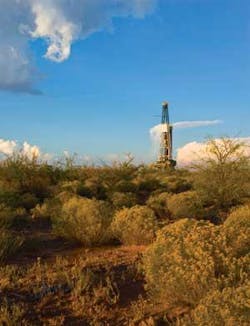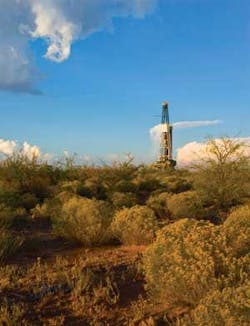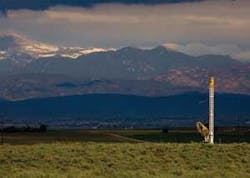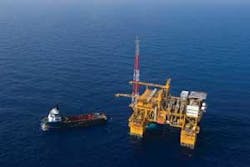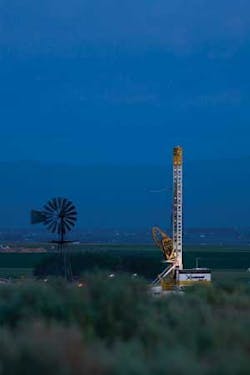2007 a remarkable year for Anadarko
Don Stowers Editor, OGFJ
Currently one of the largest US independent oil and gas companies, Anadarko Petroleum accomplished a lot in the past year, including integrating three companies into one.
All photos courtesy of Anadarko Petroleum Corp.
Like many US independents, Anadarko Petroleum Corp. has always been primarily a North American company. But, unlike some, Anadarko is applying its skill sets globally as well.
Past successes in places like Algeria, China, Brazil, and now Ghana are evidence of the company’s international objectives. However, the engine that helps drive the company is its large fairway positions in multiple high-quality basins like Greater Natural Buttes, the Powder River basin, Wattenberg field, Pinedale, and Carthage.
In terms of net income and stockholders’ equity, Anadarko ranks eighth in the former category and seventh in the latter, according to the most recent OGJ200 Quarterly Report of financials of US producers. Ranked by total assets, Anadarko leapfrogged from the No. 7 to the No. 4 position in the rankings in the third quarter of 2007, trailing only oil majors Exxon Mobil Corp., ConocoPhillips, and Chevron Corp.
Oil & Gas Financial Journal recently spoke with James T. Hackett, Anadarko’s chairman, president, and CEO, to discuss the company’s current position in the energy sphere and where it is headed. Hackett joined Anadarko in 2003 as president and CEO. Prior to that he served as president and COO of Devon Energy Corp. following its merger with Ocean Energy, where he served as chairman, president, and CEO. He holds a bachelor’s degree from the University of Illinois and an MBA from Harvard.
But first, a brief history of the company: Anadarko began as a subsidiary of Panhandle Eastern Corp. in 1959 following the discovery of large amounts of natural gas in the Anadarko basin in the Texas and Oklahoma panhandle region. On Oct. 1, 1986, Anadarko Petroleum Corporation officially became an independent company. Today, Anadarko is active in more than a dozen countries around the world. However, most of the company’s proved reserves and production are in the United States.
Anadarko has been in the vanguard of some of the petroleum industry’s most significant technological advances, including 3-D seismic imaging, drilling and completion technology, and reservoir management. The company has installed eight visualization laboratories in its headquarters complex in The Woodlands, Tex., just north of Houston. The labs enable Anadarko to utilize sophisticated modeling tools to better evaluate drilling prospects and investment options.
In one of the oil industry’s largest mergers, Anadarko simultaneously acquired Kerr-McGee Corp. and Western Gas Resources in 2006 for a combined total of $23.3 billion, including assumed debt. This huge transaction enabled the company to focus its operating strategy on higher-quality and a lower-risk asset base. Anadarko financed the acquisitions through a $24 billion committed acquisition facility provided by UBS, Credit Suisse, and Citigroup.
Subsequent to that deal, Anadarko has sold off non-core assets to the tune of approximately $20 billion pre-tax. This includes the sale of its wholly-owned subsidiary, Anadarko Canada Corp., as part of its portfolio refocusing efforts. A substantial part of the proceeds from these sales has gone to pay down debt.
The merger of Kerr-McGee and Western Gas Resources into Anadarko created one of the largest US-based independent exploration and production companies. Kerr-McGee’s core properties are located in the deepwater Gulf of Mexico and onshore in Colorado and Utah. They included 504 deepwater GoM blocks, encompassing seven operated and three non-operated producing fields, three operated and five non-operated discoveries in varying stages of development, and four additional prospects.
In Colorado, Kerr-McGee assets included approximately 550,000 net acres in the Wattenberg natural gas play, located largely on the Land Grant, where Anadarko owned the royalty interest. In Utah, Kerr-McGee’s holdings included about 225,000 net acres in the Uinta basin’s prolific Greater Natural Buttes gas play.
More recently, in 2007, the record-breaking, ultra deepwater Independence Project in the Gulf of Mexico came on stream. It established new milestones for technological and operational achievement, and for these efforts, our sister publication, Offshore, named Enterprise Products Partners LP and Anadarko co-recipients of its prestigious Five Star Award in recognition of their accomplishments with the project.
“Independence Hub is truly one of the most remarkable accomplishments in the history of our industry,” said Hackett. “It is located in deeper water than any other facility in the world, and it produces enough clean natural gas to heat or cool about five million average American homes every day. It epitomizes the leading-edge technology that our industry has developed and implemented.”
The Hub is located in an area that was opened up for exploration in 2001, and none of the 10 discoveries were economic in and of themselves, said Hackett. “However, because of the innovative solution offered by our partners at Enterprise and the cooperation of the producers, we were able to find a means to produce these resources to the benefit of consumers in an environmentally friendly way.”
Independence Hub will serve as a blueprint for future deepwater development, according to Offshore editors. Located at Mississippi Canyon block 920 in about 8,000 feet of water, it is the deepest offshore production platform ever installed. This $2 billion development, includes the world’s largest hub in terms of offshore natural gas processing capacity, that is capable of handling up to one billion cubic feet (bcf) per day of natural gas, or roughly 12% of total natural gas deliveries from the Gulf of Mexico.
Production from the hub is transported to shore via the 134-mile Independence Trail pipeline. Located in more than 8,000 feet of water, it is the world’s deepest export pipeline.
Michael A. Creel, president and CEO of Enterprise, which originally proposed the hub in 2003 and has invested more than $650 million in the project, noted that producers acquired the exploration rights to more than 80 blocks within a 50-mile radius of the hub during the most recent sale, positioning Independence as an important component in the future development of deepwater reserves in the eastern Gulf of Mexico.
In the aftermath of huge storms like hurricanes Katrina and Rita, it is prudent to ask how GoM producers like Anadarko manage hurricane risk.
“As the largest independent deepwater producer in the Gulf of Mexico, we are well aware of the risk associated with hurricanes and other severe weather events,” said Hackett. “Our primary concern is the safety of our employees and contractors. We monitor the weather very closely. . .and will evacuate our platforms and drilling operations as soon as we perceive there may be a threat to their safety.”
He continued, “We shut in all production below the sea floor and secure equipment on the platforms to protect the environment. All of our deepwater facilities are designed to [Minerals Management Service] regulations and several have actually sustained direct hits from category four and five hurricanes with only superficial damage, so we have a lot of confidence in the robust construction of our deepwater facilities.”
Other high-impact projects
Hackett identified other high-impact projects in the development pipeline: “Anadarko’s lower risk North American onshore plays provide more than 25,000 drill sites in the Rockies and in our Texas/Mid-Continent areas and steady, predictable growth that underpins the value of our company. While the offshore and onshore production plays are the core of our business model, we’ve maintained the substantial upside of our successful and proven exploration program.
“As a result of our 2007 exploration program, we have two very high-impact deepwater projects currently in the pipeline,” he said. “The first is the deepwater Jubilee field offshore Ghana [West Africa]. We estimate the field contains between 200 million to more than a billion barrels of recoverable resources. We’ll be working with our partners on an aggressive appraisal program this year to try to narrow that range.
“The second substantial high-impact project in the pipeline is the Caesar/Tonga complex in the deepwater Gulf of Mexico,” he added. “This discovery also highlights the value of our broad infrastructure in the Gulf. Because we already have the Constitution production spar nearby, Anadarko and our partners in the Caesar/Tonga complex will be able to accelerate the value by two full years and save on capital expenditures by nearly $1 billion.”
Additionally, “We have ongoing exploration offshore Brazil as well and plan to drill an exploration well in the South China Sea this year.”
Deep Haley venture with Chesapeake
Last July, Anadarko and Chesapeake Energy announced their collaboration on a joint venture in the Deep Haley area of the Delaware basin in West Texas. In total, Anadarko and Chesapeake will jointly evaluate and explore more than one million gross acres in the area, on which drilling, completion, production, and midstream operations will be shared on roughly a 50/50 basis.
The two companies plan an aggressive drilling program for the area, with Anadarko and Chesapeake each currently operating eight drilling rigs in the Deep Haley with the possibility of increasing drilling activity as the joint venture develops.
Aubrey McClendon, Chesapeake’s chairman and CEO, commented on the venture: “We have long admired Anadarko’s capabilities in deep gas exploration and we are excited to join forces with them in the Deep Haley area, one of the country’s premier deep gas exploration projects. Our recent drilling results. . .have been exceptional, and we are confident that by joining forces with Anadarko the technical teams of the two companies will continue to enjoy success in drilling prolific wells in the Deep Haley area.”
Hackett added, “This transaction fits our strategy very well and positions us for continued growth from a core asset with a partner that understands the play. . .it was time to expand our drilling operations, and we are glad to have Chesapeake jointly involved with us. Working collaboratively will enable our companies to maximize value by accelerating development of the considerable resources in the play.”
Financing acquisitions and paying down debt
In order to finance the Kerr-McGee and Western Gas Resources acquisitions in 2006, Anadarko borrowed $22.5 billion in August of that year to finance the all-cash acquisitions. Since then, the company has been proactive in divesting certain non-core assets in order to retire this debt early. On Feb. 29, Anadarko announced it had completed the repayment of its 2006 acquisition financing.
Al Walker, Anadarko’s senior vice president and CFO, commented, “We are very pleased to retire the remaining $1 billion outstanding under the facility at year-end 2007, through a combination of cash on hand and year-to-date cash flow from operations, and to have achieved our goal of retiring the entire financing without issuing any equity.”
Hackett said he is extremely pleased that retiring the debt provides the company with added financial flexibility.
“The acquisitions of Kerr-McGee and Western Gas have proven to be very successful from a portfolio perspective,” he noted. “Anadarko now has a strong future growth position with its huge inventory of development projects in the US onshore, especially in expanding areas like the Greater Natural Buttes and Powder River basins. We also control significant midstream assets, especially in the Rockies, where water disposal, gathering, processing, and exporting capacity are keys to growth in a company’s assets.”
“It was a remarkable year when you consider all of this was accomplished while integrating three companies into one, converting to the successful efforts method of accounting, filing a registration statement for an IPO of a midstream MLP, and implementing a new universal software system.” – Jim Hackett, Anadarko President, Chairman and CEO
Hackett added, “Since the time of the acquisitions in August 2006, we have strategically divested of properties that were either considered non-core, had steeper production declines, or were more capital intensive. Through this process, we were able to systematically pay down debt and meet our year-end 2007 target of $12 billion of net long-term debt.
“It was a remarkable year when you consider all of this was accomplished while integrating three companies into one, converting to the successful efforts method of accounting, filing a registration statement for an initial public offering of a midstream master limited partnership, and implementing a new universal software system,” stated Hackett.
Recent asset sale to StatoilHydro
Anadarko recently sold its 50% interest in the Peregrino field offshore Brazil and its 25% stake in the BP-operated Kaskida Unit in the deepwater Gulf of Mexico to Norway’s StatoilHydro for $1.8 billion plus additional consideration with a present value of $300 million. Hackett explained how this came about and how it fits into the company’s broader plan.
“We were not actively marketing Peregrino. However, StatoilHydro came to us with a compelling, unsolicited offer that made a lot of sense to us from a strategic standpoint,” he said. “The sale accelerated the net present value of these assets and enabled us to redirect the capital that we intended to spend developing Peregrino and Kaskida into our extensive nearer-term development opportunities in the US onshore.
“We are committed to our deepwater exploration program offshore Brazil and in the Gulf of Mexico,” Hackett hastened to add. “We believe that the skill sets we’ve developed in the Gulf of Mexico transfer well to the deepwater basins offshore Brazil. We’re currently drilling one prospect in the Espírito Santo basin and plan to drill about three more subsalt prospects this year. We’ll be moving the Deepwater Millennium drillship to Brazil to help in that effort.
“The Gulf of Mexico remains a core area for us,” he emphasized. “We have an extensive acreage position and infrastructure in place that allows us to utilize a hub-and-spoke philosophy, so that discoveries can be tied back to existing platforms more quickly and cost effectively. We also have more than 150 identified prospects in the deepwater Gulf and will be testing about six to eight prospects this year.”
Capex budget for 2008
An approximate breakdown of Anadarko’s capital budget by area for the current year shows that 75% of capital outlay is for domestic upstream activity – 30% Rocky Mountains, 25% Deepwater GoM, and 20% Southern US. About 15% is directed at international and frontier, and another 10% is midstream.
Asked about the emphasis on domestic upstream, Hackett responded, “These assets (high-quality growth basins in the Rockies and elsewhere) are lower-risk, predictable, and repeatable, and we are focused on accelerating the value of these assets, which is reflected in the amount of capital we have directed toward them. We also have a very successful Gulf of Mexico exploration program that provides significant upside potential inside North America.
He said that Anadarko applies its skill sets globally as well, as shown by past and current successes in Algeria, China, Brazil, and West Africa. “These are evidence of our ambitions internationally,” he said, adding that the company has increased its international exploration and appraisal activities in 2008.
Deepwater royalty issue
Anadarko inherited a legal controversy from Kerr-McGee in the form of a case regarding a royalty relief program for deep well natural gas and petroleum exploration in publicly owned waters. The former Oklahoma City-based company sued the US Department of the Interior, and the case is still making its way through the federal court system.
The federal government contends that Anadarko, as the current owner of Kerr-McGee assets, owes the government millions of dollars in back royalties for production developed on public leases where commodity prices rose above price thresholds that were inserted into the leases by the Department of the Interior. The apparent question is whether or not the Department of the Interior had the discretion to insert price thresholds into the leases. The company claims it does not, because the price thresholds would usurp the volume thresholds guaranteed by the Deepwater Royalty Relief Act of 1995.
Asked to comment on the status of the case, Hackett said: “The US District Court, Western District of Louisiana, Lake Charles Division, upheld what we believe was the intent of Congress to assure that companies were afforded the royalty treatment it granted as an incentive to make huge investments in the deepwater Gulf of Mexico frontier in the mid- to late-1990s. The incentives provided under the Outer Continental Shelf Deepwater Royalty Relief Act of 1995 (DWRRA) continue to provide value for American consumers in the form of energy that we and other deepwater operators have produced, as well as the jobs that have been created. This energy continues to contribute to the health, welfare, and security of our nation.”
Hackett continued, “The concern over today’s energy prices highlights the importance of increasing the supply of affordable resources. The DWRRA was a good example of sound energy policy that was very successful in establishing a reliable source of domestically produced energy. The lease bonuses, royalties, and income taxes on deepwater production paid to the federal government have grown markedly since 1995. Also, none of the leases involved in this decision are ‘royalty free’ – all provide for royalty on production after volume thresholds are exceeded. We are pleased with this district court decision affirming the industry’s adherence to the law in its efforts to increase supply.”
The Interior Department has appealed the US District Court ruling. However, said Hackett, “That does not change the facts of the case. We believe, as the lower court stated in its decision, the statute is plain and unambiguous. The Interior Department has no discretion to enact a price threshold requirement that applies to volumes below the minimum volume of royalty-free production.”
Conclusion
Anadarko has demonstrated strong and efficient performance and delivered solid production growth in the past year despite the sea changes that have occurred within the company, not the least of which is the integration of three companies into one.
“In 2007, we transformed Anadarko’s portfolio and positioned the company for consistent and predictable performance in 2008 and beyond,” said Hackett. “I am excited about the portfolio we have assembled and proud of the numerous accomplishments of our employees during the past year.”
